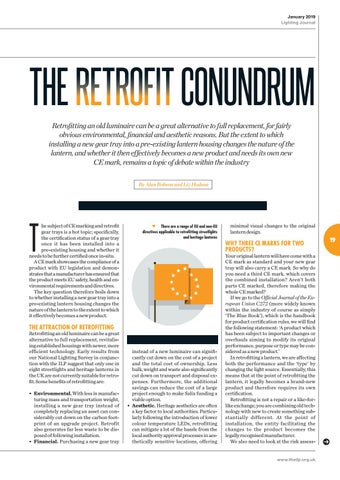January 2019 Lighting Journal
THE RETROFIT CONUNDRUM Retrofitting an old luminaire can be a great alternative to full replacement, for fairly obvious environmental, financial and aesthetic reasons. But the extent to which installing a new gear tray into a pre-existing lantern housing changes the nature of the lantern, and whether it then effectively becomes a new product and needs its own new CE mark, remains a topic of debate within the industry By Alan Robson and Liz Hudson
T
he subject of CE marking and retrofit gear trays is a hot topic; specifically, the certification status of a gear tray once it has been installed into a pre-existing housing and whether it needs to be further certified once in-situ. A CE mark showcases the compliance of a product with EU legislation and demonstrates that a manufacturer has ensured that the product meets EU safety, health and environmental requirements and directives. The key question therefore boils down to whether installing a new gear tray into a pre-existing lantern housing changes the nature of the lantern to the extent to which it effectively becomes a new product.
q There are a range of EU and non-EU directives applicable to retrofitting streetlights and heritage lanterns
THE ATTRACTION OF RETROFITTING
Retrofitting an old luminaire can be a great alternative to full replacement, revitalising established housings with newer, more efficient technology. Early results from our National Lighting Survey in conjunction with the ILP suggest that only one in eight streetlights and heritage lanterns in the UK are not currently suitable for retrofit. Some benefits of retrofitting are: • Environmental. With less in manufacturing mass and transportation weight, installing a new gear tray instead of completely replacing an asset can considerably cut down on the carbon footprint of an upgrade project. Retrofit also generates far less waste to be disposed of following installation. • Financial. Purchasing a new gear tray
instead of a new luminaire can significantly cut down on the cost of a project and the total cost of ownership. Less bulk, weight and waste also significantly cut down on transport and disposal expenses. Furthermore, the additional savings can reduce the cost of a large project enough to make Salix funding a viable option. • Aesthetic. Heritage aesthetics are often a key factor to local authorities. Particularly following the introduction of lower colour temperature LEDs, retrofitting can mitigate a lot of the hassle from the local authority approval processes in aesthetically sensitive locations, offering
minimal visual changes to the original lantern design.
WHY THREE CE MARKS FOR TWO PRODUCTS?
Your original lantern will have come with a CE mark as standard and your new gear tray will also carry a CE mark. So why do you need a third CE mark, which covers the combined installation? Aren’t both parts CE marked, therefore making the whole CE marked? If we go to the Official Journal of the European Union C272 (more widely known within the industry of course as simply ‘The Blue Book’), which is the handbook for product certification rules, we will find the following statement: ‘A product which has been subject to important changes or overhauls aiming to modify its original performance, purpose or type may be considered as a new product.’ In retrofitting a lantern, we are affecting both the performance and the ‘type’ by changing the light source. Essentially, this means that at the point of retrofitting the lantern, it legally becomes a brand-new product and therefore requires its own certification. Retrofitting is not a repair or a like-forlike exchange; you are combining old technology with new to create something substantially different. At the point of installation, the entity facilitating the changes to the product becomes the legally recognised manufacturer. We also need to look at the risk assesswww.theilp.org.uk
19
